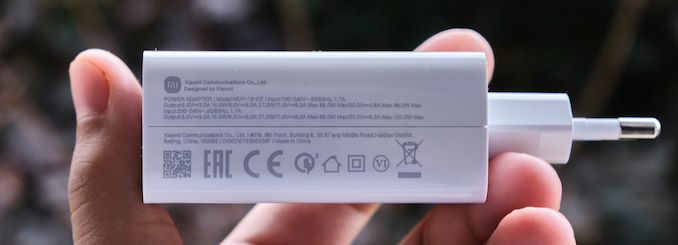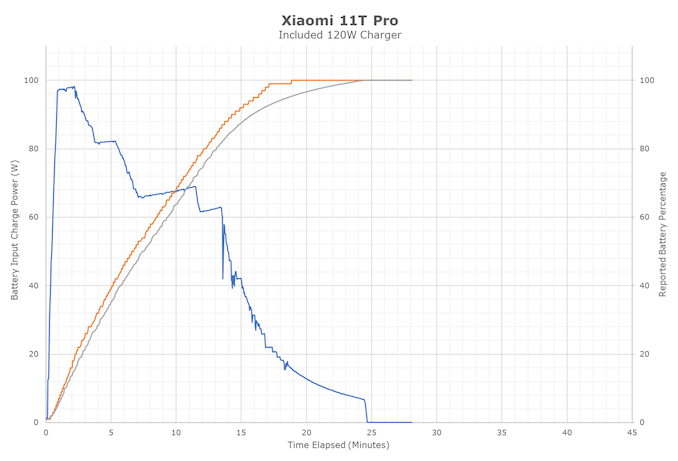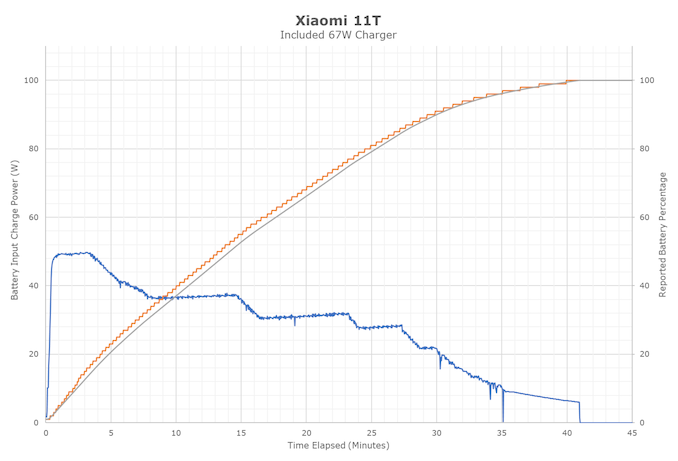The Xiaomi 11T & 11T Pro Review: Two Chips, With a Battery Focus
by Andrei Frumusanu on September 15, 2021 9:00 AM EST- Posted in
- Mobile
- Smartphones
- Xiaomi
- Xiaomi 11T
- Xiaomi 11T Pro
Fast Charging Note
Xiaomi is focusing the PR of the Mi 11T series on the fast-charging capabilities. Notably, the 11T Pro comes with a 120W fast charger:
It’s a USB-A connector on the power brick, and we can see that to achieve 120W the phone uses 20V and 6A transmission. The 6A is the rather special part as this requires a special thicker cable that’s included – otherwise any other generic cable will not allow to these kinds of power levels.
In terms of charging, we can see that the actual charge power into the phone reaches around 97W. The brick at the wall consumed up to 115W – keep that in mind when reading about fast-charging marketing claims, it’s mostly always the at the wall figure that’s being advertised.
The 97W figure only works up to around 20% charge, after which it goes down in steps to 80W to around 40%, 65-70W to 70%, and then gradually down to 6W. It’s notable that the phone doesn’t really do any trickle-charging at all. 0-100% happens in 25 minutes.
The regular 11T comes with a 67W charger, 20V at 3.25A. Peak power is around 49W in terms of charging the battery. It’s in general less aggressive, with 0-100% in 41 minutes.
Xiaomi made a few claims about the charging system a extract of the latest PR:
Xiaomi’s first smartphone to launch globally with the company's proprietary 120W Xiaomi HyperCharge technology. The industry-leading technology will enable a 100% charge in just 17 minutes*, giving creators more time to keep up with their creativity and minimize downtime by ensuring a full day use. This is achieved through innovative technologies such as dual charge pumps, dual-cell battery structure, MTW, Graphene application on Li-ion battery and Mi-FC technology. The safety of the battery is guaranteed by a TÜV Rheinland Safe Fast-Charge System Certification, 34 charging and battery safety features, real-time temperature monitoring and other measures
Notably, we had a few questions about the claims. First of all, the 17 minute claim is generally bogus – while yes, the phone does showcase a 100% status after around 17 minutes, which we reproduced, it actually doesn’t stop until around 25 minutes, when it reaches a true 100% figure. This is called fuzzy logic battery percentage reporting, and is generally used as a psychological incentive to not let your phone charge to 100% - almost every vendor out there does this, some to much worse discrepancies than showcased here.
We had sent Xiaomi a set of questions about 4 weeks ago, and gotten some answers only 2 days ago:
Q. Can we document the 34 safety features features?
A. Battery: High temperature charging/discharging protection, Low temperature charging/discharging protection, High current charging threshold management, Double overcharge protection, Overcurrent charging/discharging protection, Short circuit protection, Over-discharge protection, Battery safety encryption;
Circuit: Watch Dog, USB input over voltage protection, USB input under voltage protection, USB input overcurrent protection, Main charger Vout over voltage protection, Window under voltage protection, Window over voltage protection, Reverse current protection, Overheating shutdown protection, SMB VBAT protection, IBAT OCP protection, 2:1 input OVP protection, 2:1 output OVP protection, Battery monitoring system, Jeita charging protection, CC time out protection, PPS attach protection, PD authentication protection, Overheating NTC IC protection;
Charger: Short circuit protection, Overcurrent protection and overvoltage protection, Under voltage protection, Over-temperature protection, Cable encryption protection, Lightning protection, Electrostatic protection.
I questioned about the 34 charging features, and got an extensive list back as an answer. Generally, all these features are very much generic mechanisms that can be found in almost any smartphone, and are fundamental to any charge system, with only a few specific ones related to the serial battery charging being in any way special here.
Q. - What does up to 800 cycles mean? What are the criteria for this figure? Usually there's always some specification such as "retain up to 80% charge after 800 cycles".
- How were the charging cycles tested? What was the depth of charge of the battery (from which percentage start of charge to which percentage stop of charge) - are these partial of full charge cycles?
- How much more is the battery degraded compared to regular charging speeds? Does Xiaomi have any data to share in regards to battery health?
A. [...] The battery can obviously handle way more than just 800 cycles. You are absolutely right, the idea here is that it will maintain 80% of its capacity after 800 charging cycles, which is roughly two years before you'll notice any real difference. For most smartphones that number stands at only 500 cycles. The testing conditions are simple, we test the batteries under room temperature charging and discharging it thousands of times to make sure that the battery is able to retain most of its capacity.
In the initial PR a few weeks ago the 80% figure wasn’t mentioned, hence why I asked about the 800 cycles number.
In general, the issue we’ve been having with a lot of vendors is that we are having a lot of issue in getting anybody to actually specify the exact details of the test environment of these charge cycle tests and results.
In particular, I’m asking about the depth of charge of the test – a cycle can either be a full 0-100% charge, or it can also be 5 40-60% charges, in battery terminology, both of those count as a full cycle, however the 0-100% cycle will put significantly more stress and degrade the battery a lot more than the 5x 40-60% cycles.
Xiaomi here also isn’t very clear in their answer and didn’t address the question. Particularly, they talk about “most smartphones” only able to achieve 500 cycles, however, most smartphones don’t have 120W charging, so it can’t possibly be a valid comparison.
Xiaomi also notes that the battery is tested under “lab conditions” – this was also a topic of kerfuffle we’ve had with OPPO last year as the company kept producing questionable test results without any context of test methodology.
Usually, these battery stress tests are done via industrial battery charge/discharge capacity testers, meaning they are testing merely the battery cell, outside of the phone - a very important distinction compared to actual phone charge cycle stress testing.
Q Follow-up. - Can I get a clarification as whether this means that the batteries are being tested externally, outside of the phone, or if this means that the phone itself is being charged and discharged with the 120W system?.
I followed-up with the above question for clarification. This was also a stickling point with OPPO last year, as they would refuse to answer that the advertised charge cycles and capacity retention was actually tested with the advertised fast-charging system. I haven’t had a response from Xiaomi yet on the matter, however this was extremely close to the embargo time, I'll make sure to follow up if they do respond.
Q. For the TÜV certification - we've had similar claims from other OEMs, but the issue was that the certification doesn't have any public test methodology documented, nor are the exact results ever published. It is our understanding that this certification only essentially checks that the device doesn't result in any hazardous situation, but doesn't test things like battery health. Any more information is helpful."
A.Correct, the TÜV and other battery safety certifications are mainly focused on battery safety, and not on battery health.
However, at Xiaomi we use laboratory cycle verification, third-party laboratory tests, and ORT verification methods to ensure that the battery cycle life meets the highest standards.
Finally, I asked about clarification about the TÜV certifications. This was also a stress point in an interaction with OPPO last year, as they were trying to portray that the TÜV certification actually is testing battery degradation. Documents sent to me at the time were clear that they were completely unrelated to the fast-charge system.
Xiaomi deserves credit here to properly dismissing that notion and confirming that the TÜV certification is only related to safety – as in, they test that the charger or phone don’t blow up. Battery health and degradation is unrelated to the (non-public) test-procedures and certification.
Unfortunately, it’s been extremely hard to get a clear non-evasive answer from any vendors out there that promotes such extreme fast-charging systems. Xiaomi here also wasn’t able to produce any kind of convincing evidence that would argument that the 120W charging system doesn’t notably impact battery degradation.
We’re in the process of writing up a more dedicated and general fast-charging article that focuses on real data, and the actual latest science on fast charging. There is an incredible amount of misinformation, misconceptions, and outright falsehoods that are floating out there that we want to address.













41 Comments
View All Comments
zodiacfml - Wednesday, September 15, 2021 - link
not only does 120w charging is crazy, it also appears to charge at a high rate even at 80% battery state. tricks I know is to use two batteries in series and using larger capacity batteries than advertised or lower voltage cutoff. however, those tricks don't appear enough to get up to 120w.yetanotherhuman - Thursday, September 16, 2021 - link
It'd be nice to see some phones again one day, and not just phablets.Linustechtips12 - Thursday, September 16, 2021 - link
very much agreed I will not ever go for an iPhone sorry... but I want the size in between something like the 13 mini and the regular 13 or just a smidge smaller than the s21, the s21 is actually almost perfect coming from an s10e I hope the overall size of the 22 is slightly smaller or the same size as the s10eTheinsanegamerN - Friday, September 17, 2021 - link
So, on a phone like this, how would that work with US carriers? It's not officially sold here, will it work with VoLTE or will these phones be bricks once the 3G networks go down?ATT and verizon are very picky about what is allowed, and while most US sold phones are supported they say nothign about xaiomi.
coolkwc - Sunday, September 19, 2021 - link
If you ever own a fast charging phone and power meter, you will know the 'algorithm' behind the fast charging. The charge current is reduce in staggered, however from what i saw, it is based on temperature capped rather than preset according to SoC. You will noticed that it will reduce the charge in order to keep temperature under 40'C. So if your phone temperature is at the high side when you plug in the charger, the fastest charge rate will not even activated/sustained for any longer, however it will sustain longer if the charge temperature is low. I'm using the Mi 11 Ultra with 67W charger, to preserve the battery life i normally charge using my old QC3.0 samsung charger at home and only charge until 4.3V which is 85-90% full, the sustain charge current is at around 3.5A for the whole charging period. The bundle 67W Xiaomi charger serve as my quick 'travel' charger where i will use when i need a fast top up, which not often based on my use case.Plumplum - Monday, September 20, 2021 - link
Installation of monitoring apps can show problems with CPU behavior...why wasn't it done on the first test?ROM was responsible of the problem.
Problem with Anandtech is how fast they're to accuse Mediatek without asking them questions on how the device and sometime some benchmarks (such as PCMark) behave.
That was already the same with so called cheating.
Unfortunatelly post people won't read the corrected article. The damage is done!
Should made a separate article to apologize!
Premade thought leads to unfair review.
iphonebestgamephone - Saturday, September 25, 2021 - link
Nothing was wrong in cheating one back then. Mediatek not including the cheat mode in dimensity should be enough to tell you all about it.xol - Monday, September 20, 2021 - link
Hot take 1The Cortex X1 is a bad core. Not bulldozer bad but pentium hot/bad/inneficient, which is doubly bad in a mobile environment. ARM added lots of cache and didn't add enough functional units to make it worthwhile. It's half the M1 design - all the cache but lacks the pipeline. bad.
Hot Take 2
Manufacturers (qualcom/xiaomi) know this but can't avoid using latest/"best" core in their latest designs because product spec sheets > actual real world utility.
Hot Take 3
Manufacturers know this too (hot take 2) but still need to use the "bad" X1 cores in their flagships because they need to be "flagship". But the core is crappy and give bad battery life. So they're compensating by essentially disabling as much as they can. (pretty much fact and not hot take)
A ide Hot Take 4
Snapdragon 888 is a "bad" chip too, and not just the X1 core, also the GPU. Quallcomm use the node advantage (5 vs 7nm) to squeeze extra frequency out of their designs, They claim +50% ALU in the new chip (vs 865) but/and clock it at 840 vs 650MHz (+29%). But performance is only +25%. There's real world evidence that the 888 runs hot and thermally throttles in phones way earlier than 865, despite being on 5nm -
sweetca - Tuesday, September 21, 2021 - link
I prefer my spying domestic.Yourdailytask - Thursday, September 23, 2021 - link
hello admingrate post